[English] 日本語
 Yorodumi
Yorodumi- EMDB-3146: Mechanism of eIF6 release from the nascent 60S ribosomal subunit -
+ Open data
Open data
- Basic information
Basic information
| Entry | Database: EMDB / ID: EMD-3146 | |||||||||
|---|---|---|---|---|---|---|---|---|---|---|
| Title | Mechanism of eIF6 release from the nascent 60S ribosomal subunit | |||||||||
 Map data Map data | Reconstruction of 60S-eIF6-SBDS-EFL1 complex | |||||||||
 Sample Sample |
| |||||||||
 Keywords Keywords | ribosome / ribosomopathy / SBDS / cryo-EM / eIF6 / Dictyostelium / EFL1 / GTPase / ribosome biogenesis | |||||||||
| Function / homology |  Function and homology information Function and homology information: / Downregulation of ERBB2:ERBB3 signaling / L13a-mediated translational silencing of Ceruloplasmin expression / APC/C:Cdc20 mediated degradation of Cyclin B / Autodegradation of Cdh1 by Cdh1:APC/C / APC/C:Cdc20 mediated degradation of Securin / APC/C:Cdh1 mediated degradation of Cdc20 and other APC/C:Cdh1 targeted proteins in late mitosis/early G1 / Cdc20:Phospho-APC/C mediated degradation of Cyclin A / APC-Cdc20 mediated degradation of Nek2A / SRP-dependent cotranslational protein targeting to membrane ...: / Downregulation of ERBB2:ERBB3 signaling / L13a-mediated translational silencing of Ceruloplasmin expression / APC/C:Cdc20 mediated degradation of Cyclin B / Autodegradation of Cdh1 by Cdh1:APC/C / APC/C:Cdc20 mediated degradation of Securin / APC/C:Cdh1 mediated degradation of Cdc20 and other APC/C:Cdh1 targeted proteins in late mitosis/early G1 / Cdc20:Phospho-APC/C mediated degradation of Cyclin A / APC-Cdc20 mediated degradation of Nek2A / SRP-dependent cotranslational protein targeting to membrane / Separation of Sister Chromatids / Senescence-Associated Secretory Phenotype (SASP) / Autodegradation of the E3 ubiquitin ligase COP1 / ABC-family proteins mediated transport / AUF1 (hnRNP D0) binds and destabilizes mRNA / Degradation of DVL / N-glycan trimming in the ER and Calnexin/Calreticulin cycle / Hedgehog ligand biogenesis / Hedgehog 'on' state / : / Regulation of RAS by GAPs / MAPK6/MAPK4 signaling / UCH proteinases / Josephin domain DUBs / Ub-specific processing proteases / Metalloprotease DUBs / DNA Damage Recognition in GG-NER / Formation of Incision Complex in GG-NER / : / Formation of TC-NER Pre-Incision Complex / Dual incision in TC-NER / Gap-filling DNA repair synthesis and ligation in TC-NER / CDK-mediated phosphorylation and removal of Cdc6 / Ubiquitin-Mediated Degradation of Phosphorylated Cdc25A / Formation of a pool of free 40S subunits / GTP hydrolysis and joining of the 60S ribosomal subunit / Synthesis of active ubiquitin: roles of E1 and E2 enzymes / E3 ubiquitin ligases ubiquitinate target proteins / Regulation of PTEN localization / Regulation of PTEN stability and activity / ER Quality Control Compartment (ERQC) / Interleukin-1 signaling / Peroxisomal protein import / Endosomal Sorting Complex Required For Transport (ESCRT) / Negative regulators of DDX58/IFIH1 signaling / Pexophagy / KEAP1-NFE2L2 pathway / Regulation of NF-kappa B signaling / Nonsense Mediated Decay (NMD) independent of the Exon Junction Complex (EJC) / Nonsense Mediated Decay (NMD) enhanced by the Exon Junction Complex (EJC) / Regulation of pyruvate metabolism / Orc1 removal from chromatin / Cyclin D associated events in G1 / FBXL7 down-regulates AURKA during mitotic entry and in early mitosis / Neddylation / Iron uptake and transport / Antigen processing: Ubiquitination & Proteasome degradation / Aggrephagy / Regulation of necroptotic cell death / leukocyte chemotaxis / bone marrow development / GTP metabolic process / inner cell mass cell proliferation / maturation of 5.8S rRNA / bone mineralization / ribosomal large subunit binding / hematopoietic progenitor cell differentiation / translation elongation factor activity / ribosomal subunit export from nucleus / maturation of LSU-rRNA / phagocytic vesicle / lipid droplet / translation initiation factor activity / extracellular matrix / assembly of large subunit precursor of preribosome / cytosolic ribosome assembly / ribosomal large subunit biogenesis / mitotic spindle organization / modification-dependent protein catabolic process / protein tag activity / spindle pole / rRNA processing / ribosome biogenesis / ribosome binding / large ribosomal subunit rRNA binding / microtubule binding / cytosolic large ribosomal subunit / Hydrolases; Acting on acid anhydrides; Acting on GTP to facilitate cellular and subcellular movement / cytoplasmic translation / rRNA binding / protein ubiquitination / structural constituent of ribosome / ribosome / translation / ribonucleoprotein complex / GTPase activity / mRNA binding / ubiquitin protein ligase binding / GTP binding / nucleolus Similarity search - Function | |||||||||
| Biological species |   Homo sapiens (human) Homo sapiens (human) | |||||||||
| Method | single particle reconstruction / cryo EM / Resolution: 4.1 Å | |||||||||
 Authors Authors | Weis F / Giudice E / Churcher M / Jin L / Hilcenko C / Wong CC / Traynor D / Kay RR / Warren AJ | |||||||||
 Citation Citation |  Journal: Nat Struct Mol Biol / Year: 2015 Journal: Nat Struct Mol Biol / Year: 2015Title: Mechanism of eIF6 release from the nascent 60S ribosomal subunit. Authors: Félix Weis / Emmanuel Giudice / Mark Churcher / Li Jin / Christine Hilcenko / Chi C Wong / David Traynor / Robert R Kay / Alan J Warren /   Abstract: SBDS protein (deficient in the inherited leukemia-predisposition disorder Shwachman-Diamond syndrome) and the GTPase EFL1 (an EF-G homolog) activate nascent 60S ribosomal subunits for translation by ...SBDS protein (deficient in the inherited leukemia-predisposition disorder Shwachman-Diamond syndrome) and the GTPase EFL1 (an EF-G homolog) activate nascent 60S ribosomal subunits for translation by catalyzing eviction of the antiassociation factor eIF6 from nascent 60S ribosomal subunits. However, the mechanism is completely unknown. Here, we present cryo-EM structures of human SBDS and SBDS-EFL1 bound to Dictyostelium discoideum 60S ribosomal subunits with and without endogenous eIF6. SBDS assesses the integrity of the peptidyl (P) site, bridging uL16 (mutated in T-cell acute lymphoblastic leukemia) with uL11 at the P-stalk base and the sarcin-ricin loop. Upon EFL1 binding, SBDS is repositioned around helix 69, thus facilitating a conformational switch in EFL1 that displaces eIF6 by competing for an overlapping binding site on the 60S ribosomal subunit. Our data reveal the conserved mechanism of eIF6 release, which is corrupted in both inherited and sporadic leukemias. | |||||||||
| History |
|
- Structure visualization
Structure visualization
| Movie |
 Movie viewer Movie viewer |
|---|---|
| Structure viewer | EM map:  SurfView SurfView Molmil Molmil Jmol/JSmol Jmol/JSmol |
| Supplemental images |
- Downloads & links
Downloads & links
-EMDB archive
| Map data |  emd_3146.map.gz emd_3146.map.gz | 14.3 MB |  EMDB map data format EMDB map data format | |
|---|---|---|---|---|
| Header (meta data) |  emd-3146-v30.xml emd-3146-v30.xml emd-3146.xml emd-3146.xml | 14 KB 14 KB | Display Display |  EMDB header EMDB header |
| Images |  emd_3146.jpg emd_3146.jpg | 270 KB | ||
| Archive directory |  http://ftp.pdbj.org/pub/emdb/structures/EMD-3146 http://ftp.pdbj.org/pub/emdb/structures/EMD-3146 ftp://ftp.pdbj.org/pub/emdb/structures/EMD-3146 ftp://ftp.pdbj.org/pub/emdb/structures/EMD-3146 | HTTPS FTP |
-Validation report
| Summary document |  emd_3146_validation.pdf.gz emd_3146_validation.pdf.gz | 253.2 KB | Display |  EMDB validaton report EMDB validaton report |
|---|---|---|---|---|
| Full document |  emd_3146_full_validation.pdf.gz emd_3146_full_validation.pdf.gz | 252.3 KB | Display | |
| Data in XML |  emd_3146_validation.xml.gz emd_3146_validation.xml.gz | 6.4 KB | Display | |
| Arichive directory |  https://ftp.pdbj.org/pub/emdb/validation_reports/EMD-3146 https://ftp.pdbj.org/pub/emdb/validation_reports/EMD-3146 ftp://ftp.pdbj.org/pub/emdb/validation_reports/EMD-3146 ftp://ftp.pdbj.org/pub/emdb/validation_reports/EMD-3146 | HTTPS FTP |
-Related structure data
| Related structure data |  5anbMC  3145C  3147C  5an9C  5ancC  6qklC M: atomic model generated by this map C: citing same article ( |
|---|---|
| Similar structure data |
- Links
Links
| EMDB pages |  EMDB (EBI/PDBe) / EMDB (EBI/PDBe) /  EMDataResource EMDataResource |
|---|---|
| Related items in Molecule of the Month |
- Map
Map
| File |  Download / File: emd_3146.map.gz / Format: CCP4 / Size: 100.6 MB / Type: IMAGE STORED AS FLOATING POINT NUMBER (4 BYTES) Download / File: emd_3146.map.gz / Format: CCP4 / Size: 100.6 MB / Type: IMAGE STORED AS FLOATING POINT NUMBER (4 BYTES) | ||||||||||||||||||||||||||||||||||||||||||||||||||||||||||||
|---|---|---|---|---|---|---|---|---|---|---|---|---|---|---|---|---|---|---|---|---|---|---|---|---|---|---|---|---|---|---|---|---|---|---|---|---|---|---|---|---|---|---|---|---|---|---|---|---|---|---|---|---|---|---|---|---|---|---|---|---|---|
| Annotation | Reconstruction of 60S-eIF6-SBDS-EFL1 complex | ||||||||||||||||||||||||||||||||||||||||||||||||||||||||||||
| Projections & slices | Image control
Images are generated by Spider. | ||||||||||||||||||||||||||||||||||||||||||||||||||||||||||||
| Voxel size | X=Y=Z: 1.33 Å | ||||||||||||||||||||||||||||||||||||||||||||||||||||||||||||
| Density |
| ||||||||||||||||||||||||||||||||||||||||||||||||||||||||||||
| Symmetry | Space group: 1 | ||||||||||||||||||||||||||||||||||||||||||||||||||||||||||||
| Details | EMDB XML:
CCP4 map header:
| ||||||||||||||||||||||||||||||||||||||||||||||||||||||||||||
-Supplemental data
- Sample components
Sample components
-Entire : Dictyostelium 60S carrying endogenous eIF6 with recombinant human...
| Entire | Name: Dictyostelium 60S carrying endogenous eIF6 with recombinant human SBDS and human EFL1 |
|---|---|
| Components |
|
-Supramolecule #1000: Dictyostelium 60S carrying endogenous eIF6 with recombinant human...
| Supramolecule | Name: Dictyostelium 60S carrying endogenous eIF6 with recombinant human SBDS and human EFL1 type: sample / ID: 1000 / Number unique components: 4 |
|---|
-Supramolecule #1: 60S ribosomal subunit
| Supramolecule | Name: 60S ribosomal subunit / type: complex / ID: 1 / Recombinant expression: No / Ribosome-details: ribosome-eukaryote: LSU 60S |
|---|---|
| Source (natural) | Organism:  |
| Molecular weight | Experimental: 3 MDa / Theoretical: 3 MDa |
-Macromolecule #1: Eukaryotic translation initiation factor 6
| Macromolecule | Name: Eukaryotic translation initiation factor 6 / type: protein_or_peptide / ID: 1 / Name.synonym: eIF6 Details: endogenous dictyostelium protein purified bound the 60S ribosomal subunit Number of copies: 1 / Recombinant expression: No |
|---|---|
| Source (natural) | Organism:  |
| Molecular weight | Experimental: 26 KDa / Theoretical: 26 KDa |
| Sequence | UniProtKB: Eukaryotic translation initiation factor 6 |
-Macromolecule #2: Shwachman-Bodian-Diamond syndrome protein
| Macromolecule | Name: Shwachman-Bodian-Diamond syndrome protein / type: protein_or_peptide / ID: 2 / Name.synonym: SBDS / Number of copies: 1 / Recombinant expression: Yes |
|---|---|
| Source (natural) | Organism:  Homo sapiens (human) / synonym: Human Homo sapiens (human) / synonym: Human |
| Molecular weight | Experimental: 29 KDa / Theoretical: 29 KDa |
| Recombinant expression | Organism:  |
| Sequence | UniProtKB: Ribosome maturation protein SBDS |
-Macromolecule #3: Elongation factor-like 1
| Macromolecule | Name: Elongation factor-like 1 / type: protein_or_peptide / ID: 3 / Name.synonym: EFL1 / Number of copies: 1 / Recombinant expression: Yes |
|---|---|
| Source (natural) | Organism:  Homo sapiens (human) / synonym: Human Homo sapiens (human) / synonym: Human |
| Molecular weight | Experimental: 125 KDa / Theoretical: 125 KDa |
| Recombinant expression | Organism:  |
| Sequence | UniProtKB: Elongation factor-like GTPase 1 |
-Experimental details
-Structure determination
| Method | cryo EM |
|---|---|
 Processing Processing | single particle reconstruction |
| Aggregation state | particle |
- Sample preparation
Sample preparation
| Buffer | pH: 7.5 Details: 50 mM HEPES-KOH, 100 mM K(CH3COO), 10 mM Mg(CH3COO)2, 6 mM beta-mercaptoethanol |
|---|---|
| Grid | Details: quantifoil R2/2 glow discharged |
| Vitrification | Cryogen name: ETHANE / Chamber humidity: 100 % / Chamber temperature: 120 K / Instrument: FEI VITROBOT MARK III / Method: 6.5s blot |
- Electron microscopy #1
Electron microscopy #1
| Microscopy ID | 1 |
|---|---|
| Microscope | FEI TITAN KRIOS |
| Alignment procedure | Legacy - Astigmatism: Objective lens astigmatism was corrected at 59,000 times magnification |
| Date | Sep 3, 2013 |
| Image recording | Category: CCD / Film or detector model: FEI FALCON II (4k x 4k) / Number real images: 3844 / Average electron dose: 30 e/Å2 Details: Every image is the average of 16 frames recorded by the direct electron detector |
| Electron beam | Acceleration voltage: 300 kV / Electron source:  FIELD EMISSION GUN FIELD EMISSION GUN |
| Electron optics | Calibrated magnification: 105263 / Illumination mode: FLOOD BEAM / Imaging mode: BRIGHT FIELD / Cs: 2.2 mm / Nominal defocus max: 2.8 µm / Nominal defocus min: 2.2 µm / Nominal magnification: 59000 |
| Sample stage | Specimen holder model: FEI TITAN KRIOS AUTOGRID HOLDER |
| Experimental equipment |  Model: Titan Krios / Image courtesy: FEI Company |
- Electron microscopy #2
Electron microscopy #2
| Microscopy ID | 2 |
|---|---|
| Microscope | FEI TITAN KRIOS |
| Alignment procedure | Legacy - Astigmatism: Objective lens astigmatism was corrected at 59,000 times magnification |
| Date | Sep 6, 2013 |
| Image recording | Category: CCD / Film or detector model: FEI FALCON II (4k x 4k) / Number real images: 3844 / Average electron dose: 30 e/Å2 Details: Every image is the average of 16 frames recorded by the direct electron detector |
| Electron beam | Acceleration voltage: 300 kV / Electron source:  FIELD EMISSION GUN FIELD EMISSION GUN |
| Electron optics | Calibrated magnification: 105263 / Illumination mode: FLOOD BEAM / Imaging mode: BRIGHT FIELD / Cs: 2.2 mm / Nominal defocus max: 2.8 µm / Nominal defocus min: 2.2 µm / Nominal magnification: 59000 |
| Sample stage | Specimen holder model: FEI TITAN KRIOS AUTOGRID HOLDER |
| Experimental equipment |  Model: Titan Krios / Image courtesy: FEI Company |
- Image processing
Image processing
| CTF correction | Details: Each particle |
|---|---|
| Final reconstruction | Applied symmetry - Point group: C1 (asymmetric) / Resolution.type: BY AUTHOR / Resolution: 4.1 Å / Resolution method: OTHER / Software - Name: RELION / Number images used: 11970 |
 Movie
Movie Controller
Controller













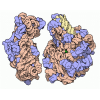
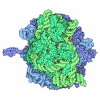

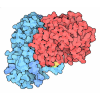
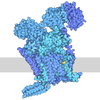


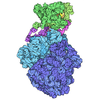


 Z (Sec.)
Z (Sec.) Y (Row.)
Y (Row.) X (Col.)
X (Col.)





















